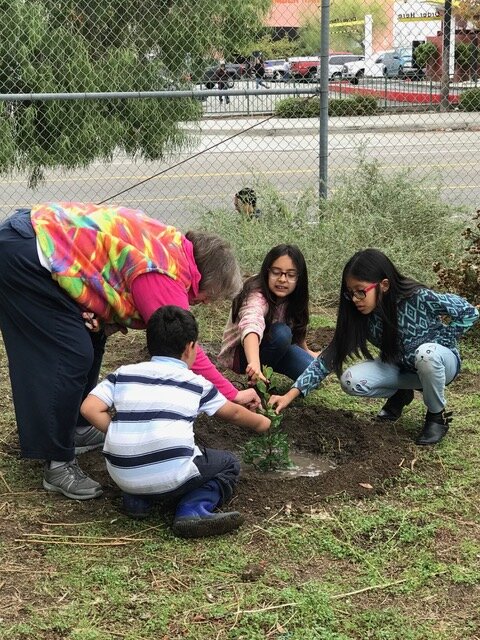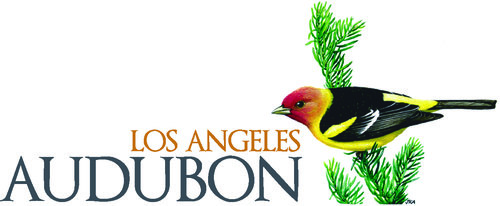Oso Flaco Lake is sandwiched between the Guadalupe-Nipomo Dunes National Wildlife Refuge and the Oceano Dunes State Vehicular Recreation Area.
A Swarm of Bees
A swarm of thousands of bees swooped into our front yard on a recent hot afternoon in October. The sound was incredible, buzzing so loudly that it attracted the attention of my neighbors. The bees quickly formed a cluster about double the size of a large football, piling up one on top of another in our bracelet myrtle tree. Then the buzzing stopped and they were calm.
My Backyard Discovery
Like all of us, I am spending these days at home gazing outside and wondering when this nightmare will end. My home office window looks out onto my garden which is filled with citrus trees, bladderpod, salvia, verbena de la mina, mullein, milkweed and punctuated with a few stately calla lilies and fragrant jasmine.
Esperanza Elementary School- Community and Habitat Building in the heart of Los Angeles
Esperanza Elementary School Students with Principal Brad Rumble and Los Angeles Audubon staff & volunteers and Baldwin Hills Greenhouse Program students.
Published by Los Angeles Audubon Society in the Western Tanager, Vol 86 No. 3 Jan-Feb 2020
In October and November 2016, staff and Baldwin Hills Greenhouse Program students from the Los Angeles Audubon Society (LAAS) installed a schoolyard habitat at Esperanza Elementary School with the help of students and parents. This habitat is filled with California native shrubs and trees including, California Sagebrush, Black Walnut, White Sage, Gum Plant, and more. There are many benefits to installing this habitat including, but not limited to:
• Educational Resource — Teachers can use it as an outdoor classroom and cover many topics including the water cycle, plant adaptations, habitat, ecosystems and many more.
• Decreases Water Runoff — Permeable surfaces in the habitat allows rainwater to infiltrate the soil, providing water for the plants. This reduces pollutants to be carried away to the ocean.
• Increase in Native Wildlife — Esperanza is listed as a hotspot in eBird with 66 species and counting. Many migratory bird species use the habitat as a stopover site including the Yellow-rump Warbler, Burrowing Owl, and White-crowned Sparrow. In addition, other wildlife are found in this habitat including butterflies, praying mantis, ladybird beetles, native bees species, etc.
• A Greenspace in the City — Los Angeles is highly urbanized, especially near Downtown LA. The younger students are surrounded by asphalt, but this small green space allows for exploration and wonder.
• A sense of community — The surrounding community is brought together for planting and bird-watching.
Community Bird Walks
This past November [2019] LA Audubon staff member, Emily Cobar, concluded two grant projects with the South Bay/Palos Verdes Audubon (SB/PV) and the North American Association of Environmental Education (NAAEE) ee360 Community Fellowship and the Esperanza Elementary School community.
In past Western Tanager newsletters (September/October 2018 and September/October 2019 issues) – Emily covered how she was a recipient of the SB/PV Audubon mini-grant to lead community bird walks and to create calendars for the nature walk participants that included their own artwork and photographs; and how the ee360 opportunity offered her an incredible fellowship that provided professional development and leadership training. Through the fellowship, she also received a grant to provide stipends to college students and/or recent college graduates who lead the nature walks, scientific illustration workshops, and other environmental education activities at Esperanza. In the conservation and education field, there are a myriad of unpaid internships or volunteer programs, so stipends were significant to reward their time commitment and their meaningful work to the community.
The nature walks started with coffee and breakfast for the participants. Then, Esperanza Elementary School principal, Brad Rumble, led a bird walk on campus while the ee360 interns assisted. After the bird walk, the ee360 interns, led a discussion about bird migration and introduced the migration game (an education resource created by Environment for the Americas). The students loved this game as they got to be a bird and go through a migration journey.
After the migration game, we talked about watershed and water runoff. The students conducted an experiment where they pour water on asphalt and then pour water in the habitat. The students got to hypothesize, observe, and draw conclusions on the experiment.
The day had a lot of content, but it was fun and very engaging. A week after the event, one of the young participants said that they wanted to recreate the migration game– which was very meaningful to hear that a simple game can make a big impact. Is this the end though?
No, community building is not a one event type of deal. In 2020 and beyond, Emily and LAAS staff and interns hope to continue this bond of community and nature whether through nature walks or habitat restoration.





Habitat Restoration and Collaboration
On December 7, 2019, Los Angeles Audubon staff, community volunteers, along with students and their parents, helped to expand Esperanza’s schoolyard habitat. Two areas were planted with native species: the large courtyard at Esperanza Elementary School, and the area along Wilshire Blvd. Students of Esperanza spread out along the campus photographing everyone hard at work and also photographing birds out and about. Rain held out just long enough for a group of hardworking volunteers from Fulbright and from the Westwood Presbyterian Church, as well as students with their families to plant toyon, ceanothus, penstemon, buckwheat and other native plants to attract birds and pollinators. Many of the species were chosen to tolerate shady conditions because the courtyard area is often in part to full shade during the year. Principal Brad Rumble and his students led the group on a campus tour at the end of the planting to view the original schoolyard habitat, planted by the school community and Los Angeles Audubon in 2017 that is thriving with the recent rains.
As the event came to an end, every single person was given the chance to disperse native plant seeds of California Poppies and other perennials onto the habitat area they weeded from invasive plants. The event was supported by US Fish and Wildlife and Westwood Presbyterian Church.
The following photo gallery shows the habitat restoration at Esperanza in progress.





Western Snowy Plover Monitoring Program
Western Tanager, Vol. 85 No. 2, Nov-Dec 2018
Japanese Sparrow Hawk | Photo by Chukiat Nualsri
INSIDE THIS ISSUE
Western Tanager, Vol. 85 No. 2, November-December 2018
•Hawk Mountain of Thailand, By Linda Oberholtzer | Photos by: Chukiat Nualsri
•The Rufa Red Knot: A Long Distant Migrant Depends on the Delaware Bay, By Dessi Sieburth
•INTERPRETING NATURE: Connecting Science and the Spirit of Nature, By Arely Mendia Perez, Restoration & Education Staff Member; Stacey Vigallon, Director of Environmental Education
•BIRDS OF THE SEASON—October 2018, By Jon Fisher
•2018 End-of-Year Appeal, By Carol Babeli, Los Angeles Audubon’s Development Director
•Audubon California Assembly–Nov. 2-4, 2018
Western Tanager, Vol. 81 No. 5 May-Jun 2015
American Wigeon, Photo by Tony Bianchi
INSIDE THIS ISSUE
• Birds of the Season — April 2015 | Jon Fisher
• FIELD TRIP REPORT: Anza-Borrego State Park Birds, Wildflowers, Insects, and More, March 2015 | By Kurt Leuschner
• U.S. Dept. of Education honors Dorsey High School with the Green Ribbon School Award | By Stacey Vigallon, Director of Environmental Education
• The ABA Young Birder of the Year Contest 2015: Protecting our Local Birds | By Dessi Sieburth
• Disney Wildlife Conservation Representative Visits L.A. Audubon | With Stacey Vigallon & Carol Babeli
Western Tanager, Vol. 81 No. 4 Mar-Apr 2015
Anza-Borrego Desert State Park, April 1992 | Photo by Larry Sansone
INSIDE THIS ISSUE
Sometimes the Things You Want for Christmas Come Late | By Louis Tucker
Volunteer Habitat Restoration — January 2015 | Written in collaboration by Carol Babeli, LA Audubon Education Directors, Stacey Vigallon and Cindy Hardin and LA Audubon Education chair, Margot Griswold. Photos by Carol Babeli and Stacey Vigallon
Volunteer Opportunities Training
Audubon Docents Head South | By Cindy Hardin, Director of Outdoor Education, Photos by Leslie Davidson
Birds of the Season — February 2015 | By Jon Fisher
Protecting the “Least” Bell’s Vireo in California | By Dessi Sieburth
INTERPRETING NATURE — Baldwin Hills Greenhouse Program, an update | By Stacey Vigallon, Director of Environmental Education
Western Tanager, Vol. 81 No. 3, Jan-Feb 2015
INSIDE THIS ISSUE
• Birds of the Season—December 2014 | By Jon Fisher
• INTERPRETING NATURE: Los Angeles Audubon’s Teacher Training Fellowship: Working Together and Learning from Each Other, by Stacey Vigallon and Cindy Hardin
• Why Build Local Membership in LA Audubon? | By Brad Rumble
• Western Scrub-jay (Aphelocoma californica) | By Dessi Sieburth
• Los Angeles Audubon volunteers — doing important work in habitat restoration!, By Carol Babeli
• WFO Conference in Billings, Montana, June 10-14, 2015
Western Tanager, Vol. 81 No. 1, Sept-Oct 2014
Liberty Canyon, Photo by Mary Freeman
INSIDE THIS ISSUE
• Birds of the Season — August 2014, By Jon Fisher
• 7 Summits Womens Team, By Carol Babeli
• Birds, Ballona & Block Printing, By Cindy Hardin, Director of Outdoor Education
• If You Have the Urge To Visit the Metropolitan New York Area..., By Louis Tucker
• INTERPRETING NATURE: The 2013-2014 Greenhouse Intern Project Abstracts, By Stacey Vigallon, Director of Interpretation, and the Baldwin Hills Greenhouse Interns
• VOLUNTEER OPPORTUNITIES: Ballona Wetlands Volunteer Docent Training, Kenneth Hahn State Recreation Area Volunteer Docent Training, Business, Community & Alumni Groups Ongoing Restoration Work










